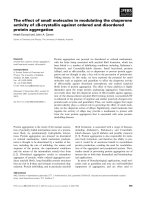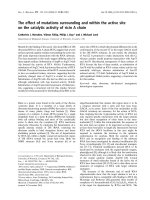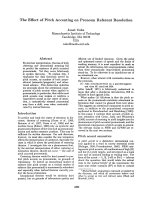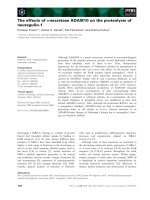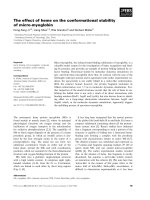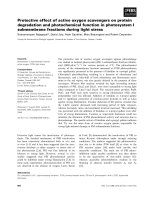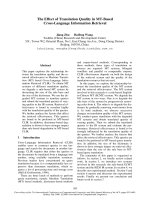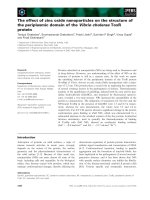Báo cáo khoa học: "The effect of intraoperative specimen inking on lumpectomy re-excision rates" pdf
Bạn đang xem bản rút gọn của tài liệu. Xem và tải ngay bản đầy đủ của tài liệu tại đây (159.51 KB, 4 trang )
RESEARC H Open Access
The effect of intraoperative specimen inking on
lumpectomy re-excision rates
Mansher Singh
1,2
, Gayatri Singh
2
, Kevin T Hogan
1
, Kristen A Atkins
3
, Anneke T Schroen
1*
Abstract
Background: Lumpectomy re-excision to obtain negative margins is common. We compare the effect of two
specimen orientation approaches on lumpectomy re-excision rates.
Methods: All women undergoing lumpectomy for breast cancer by a single surgeon between 03/2007 - 02/2009
were included. Lumpectomies underwent standard inking (SI) after surgery by a pathologist from 03/2007-02/2008
while intraoperative inking (II) with direct surgeon input was done from 03/2008-02/2009. Rates of margin positivity
and re-excision were compared between these methods.
Results: 65 patients were evaluated, reflecting SI in 39 and II in 26 cases. Margin positivity rates of 46% [SI] vs. 23%
[II] (p = 0.06) and re-excision rates of 38% [SI] vs. 19% [II] were observed. Residual disease at re-excision was found
in 27% [SI] vs. 67% [II] of cases.
Conclusions: Intraoperative inking in this practice offered a simple way to reduce re-excision rates after
lumpectomy and affect an improvement in quality of patient care.
Background
Achieving negative margins remains one of the most
important determinants for local recurrence following
breast conserving therapy [1]. Re-excision rates after
lumpectomy for the treatment of breast cancer to
achieve negative margins have be en reported between
20-60% [2-5]. Re-excision lumpectomy may lead to
diminished cosmetic results, delays in adjuvant therapy,
and additional anxiety and expense. In order to mini-
mize the tissue volume removed at re-excision, directed
re-excision can be performed with accurate specimen
orientation [6]. Directed re-excision of positive margins
typically relies on the use of up to six multi-colored inks
and reporting of separate margin status or widths. Tra-
ditionally, the contour of the lumpectomy specimen is
oriented by the surgeon by placing stitches to mark two
or more of the six sides which later allows the patholo-
gist to reorient the specimen and ink it with six different
colors to mark the anterior, posterior, medial, lateral,
superior and inferior sides. Discordance between the
surgeon and the pathologist in margin orientation
would influence the accuracy of re-excisions. A
discordance rate of 31% has recently been reported [7].
In a quality improvement effort within our practice, we
hypothesized that re-excision rates after lumpectomy
can be reduced and the accuracy of margin re-excisions
increased through direct surgeon involvement in speci-
men inking in the operating room.
Methods
A retrospective study was performed comparing lum-
pectomy re-excision ra tes using two different specimen
orientation methods. All consecutive female patients
undergoing lumpectomy for a known cancer diagnosis
by a sing le surgeon between March 2007 and February
2009 were included. Charts from patie nts with both
known invasive and/or ductal carcinoma in situ (DCIS)
were reviewed. Patients undergoing lumpectomy after
neoadjuvant therapy were excluded. Lumpectomy speci-
mens retrieved between March 2007 - February 2008
were oriented by the surgeon with three sutures indicat-
ing the lateral, superior, and anterior sides of the lum-
pectomy. The specimens were inked by pathology at a
later time in the laboratory with six separate colors.
This is referred to as the standard inking (SI) regimen.
Lumpectomy specimens retrieved between March 2008
- February 2009 were similarly marked with three
* Correspondence:
1
Department of Surgery, University of Virginia, Charlottesville, Virginia, 22908,
USA
Singh et al. World Journal of Surgical Oncology 2010, 8:4
/>WORLD JOURNAL OF
SURGICAL ONCOLOGY
© 2010 Singh et al; licensee BioMed Central Ltd. This is an Open Access article distributed under the terms of the Creative C ommons
Attribution License ( which permits unrestrict ed use, distribution, and reproduction in
any medium, provided the original work is properly ci ted.
sutures and then inked in the operating room by the
surgeon and pathologist together using the same six col-
ors. This is referred to as the intraoperative inking (II)
regimen. Specimens removed with wire localization in
the SI group were first sent to mammography for speci-
men radiograph prior to being sent to pathology for ink-
ing; in the II group, specimens were inked prior to being
sent to mammography. Specimen radiographs were per-
formed for all lumpectomies with wire localization but
compression was not routinely used during specimen
radiography. Lum pectomies performed at a freestanding
outpatient surgery center wer e included in the SI group
as intraoperative inking by pathology was not available
at this facility. Additional margins were excised at time
of original lumpectomy at the surgeon’s discretion based
on gross or radiographic impression of a close margin.
Patient records were reviewed for patient age, wire
localization, tumor size, tumor histology, margin status,
additional margins removed at original surgery, lum-
pectomy resection volume, and estrogen receptor (ER)
status. A positive margin was defined as presence of
invasive or intraductal cancer at the inked margin. A
close margin was defined as presence of DCIS within 3
mm of the inked margin since it is our institutional
practice to re-excise these close margins. Cases with
positive and c lose margin(s) were reviewed for margin
re-excision and whether residual disease was identified
at re-excision. The corr elation between margin status
and various patie nt and tumor characteristics was evalu-
ated. Analysis was performed usin g Microsoft Excel and
Graph Pad Prism software. A t wo-tailed chi-square t est
was used to compare proportions while the Student’st-
test was used to compare means. A p-value of 0.05 was
considered statistically significant. This study was
approvedbytheUniversityofVirginiaInstitutional
Review Board.
Results
Sixty-five consecutive, female patients underwent pri-
mary lumpectomy for a known cancer diagnosis over
the 24-month duration of the study. The SI cohort
included 39 patients and the II cohort included 26
patients. A general comparison between the two groups
is shown in Table 1. The groups appear similar in many
patient and tumor characteristics. However, the average
tumor size was larger in the II group; consequently the
proportion of lumpectomies performed for palpable
tumors and the average volume of the original lumpec-
tomies was larger in the II group. One particularly large
lumpectomy was performed in this group. This case
involved a central lumpectomy where the transverse dia-
meter of the elliptical incision was larger than required
to achieve negative margins but would afford a more
cosmetic closure. When comparing only lumpectomies
Table 1 General Characteristics for 34 Consecutive Breast
Cancer Patients Treated with Breast Conserving Surgery
Patient, Tumor, or
Surgery
Characteristic
Specimen Inking Regimen
Intraoperative
(n = 26)
Standard
(n = 39)
p-value
Patient age, mean yrs
(range)
64 (41-93) 61 (41-84) 0.59
Pre-operative
histological diagnosis
- N (%)
DCIS alone 3 (12%) 12 (31%)
Invasive ductal
carcinoma
17 (65%) 18 (46%)
Invasive ductal
carcinoma + DCIS
5 (19%) 5 (13%)
Invasive lobular
carcinoma (+/-
DCIS)
1 (%) 4 (10%) 0.18
Tumor grade - N (%)
Grade 1 3 (12%) 14 (36%)
Grade 2 11 (42%) 16 (41%)
Grade 3 12 (46%) 9 (23%) 0.04
ER positive - N (%) 20 (77%) 34 (87%) 0.28
Extensive intraductal
component - N (%)
3 (12%) 4 (10%) 0.87
Type of surgery - N
(%)
Lumpectomy with
wire localization
17 (65%) 35 (90%)
Lumpectomy 9 (35%) 4 (10%) 0.03
Invasive tumor size at
excision - mean cm
(range)
1.58 (0.4-4.3) 1.16 (0.3-2.9) 0.24
Original lumpectomy
volume - mean cm
3
(range)
73.2 (3.5-206.7) 47.0 (6.3-139.1) 0.08
Patients in whom
extra margins were
excised at original
surgery - N (%)
18 (69%) 28 (72%) 0.82
Number of extra
margins excised per
patient at original
surgery - mean
(range)
2.0 (0-6) 2.3 (0-6) 0.91
Singh et al. World Journal of Surgical Oncology 2010, 8:4
/>Page 2 of 4
with wire localization between the two groups, however,
the average lumpectomy volume was more closely
matched with 54.72 cm
3
for the II group and 45.16 cm
3
in the SI group.
The frequency of positive or close margins and results at
re-excision are shown in Table 2. Positive/close margins
were found in 46% (n = 18) of cases in the SI group com-
pared to 23% (n = 6) of the II group, a relative reduction
of 50% (p = 0.06). In both groups, some patients declined
re-excision. Of 6 patients with positive/close margins in
the II group, five patients underwent further surgery with
3 patients having a re-excision lumpectomy. Of 18 patients
with positive/close margins in the SI group, fifteen patients
underwent further surgery with 11 having a re-excision
lumpectomy. A 50% reduction in t he actual re-excision
rate was seen in the II group (19%) as compared to the SI
group (38%). Residual disease was present in 2 out of 3
patients (67%) from the II group at r e-excision as com-
pared to 3 out of 11 patients (27%) in the SI group. This
corresponded to residual disease being present in 4 of 5
specific margins (80%) in the II group at re-excision com-
pared to 4 of 20 (20%) margins in the SI group. It should
be noted, however, that the extent of DCIS in two of the II
patients made positive re-excisions more likely.
To assure that technical aspects of the surgery were
performed similarly between the two groups, we exam-
ined concordance of extra margins excised at original
lumpectomy and rate of these margins corresponding to
positive/close margins on the actual lumpectomy speci-
men. As shown in Table 2, no significant differences
were identified between the SI and II groups in concor-
dance of extra margins taken at original lumpectomy.
Additionally, the relationship between various pat ient
and tumor characteristics an d margin status was evalu-
ated. No association between margins status at original
excisio n and patient age, ER status, invasive tumor size,
or lumpectomy volume was identified. However, cases
with positive margins appeared more likely to involve
DCIS than those with negative margins at first surgery
(88% vs. 6 8% respectively, p = .08) and much more
likely to involve an extensive intraductal component
(25% vs. 2% respectively, p = .008).
Discussion
A relatively simple change in our lumpectomy specimen
inking practice produced a measurable improvement in
quality of patient care by reducing re-excision rates by
50%. Intraoperative inking p resents one of several ways
that a surgeon’ s involve ment in margin assessment can
help reduce re-excision rates. Other examples include use
of intraoperative ultrasound or use of cavity shaving [6,8].
The simplicity, low cost, and no additional training make
intraoperative inking an easy tool to apply in most settings.
The method capitalizes on the surgeon’s unique ability to
Table 2 Comparison of Intraoperative Inking Regimen
with Standard Inking Regimen
Measurement Specimen inking regimen
Intraoperative
(n = 26)
Standard
(n = 39)
P-value
1a. No. patients with
positive/close margins
at original surgery
6 (23%) 18 (46%) 0.06
*Positive margins 4 (15%) 7 (18%)
*Close margins 4 (15%) 15 (38%)
1b. No. patients who
underwent re-excision
5 (19%) 15 (38%) 0.16
†Re-excision
lumpectomy
3 (12%) 11 (28%)
†Mastectomy 3 (12%) 6 (15%)
2. No. patients with
residual disease
identified on re-
excision lumpectomy
2 of 3 (67%) 3 of 11 (27%) 0.5
3. Residual disease
identified in the
specific margins at re-
excision lumpectomy
4 of 5 (80%) 4 of 20 (20%) 0.02
4a. No. patients with
positive/close margins
on original
lumpectomy
specimen alone
9 (35%) 22 (56%) 0.08
4b. No. patients with
positive/close margins
on original
lumpectomy
specimen who had
extra margins taken
at original surgery
5 of 9 (55%) 11 of 22 (50%) 0.78
4c. No. patients with
positive/close margins
on original
lumpectomy
specimen whose
margins were cleared
by extra margins
taken at original
surgery
3 of 9 (33%) 4 of 22 (18%) 0.36
5. No. extra margins
taken at original
surgery that
corresponded to
positive/close margins
on original
lumpectomy
6 of 7 (86%) 15 of 19 (79%) 0.70
* Some patients had positive as well as close margins
† Some patients first underwent re-excision lumpectomy prior to ultimately
converting to mastectomy
Singh et al. World Journal of Surgical Oncology 2010, 8:4
/>Page 3 of 4
conceptualize the lumpectomy cavity and recreate more
accurate margin definitions on the specimen.
Our study was not designed to specifically explain why
intraoperative inking may be superior to standard inking
in reducing re-excision rates; rather the study’spurpose
was to demonstrate whether an individual surgeon’ s
practice could be improved by this change in specimen
handling. A possible explanation includes intraoperative
inking improving margin concordan ce and accuracy.
Alternately, intraoperative inking may benef it from less
ink bleeding or changes in margin measurements result-
ing from structural changes to the tissue over time, such
as flattening of the specimen or fat retraction. Addi-
tional limitations of this study may include generalizabil-
ity of the results given that the study reflects the
experiences of a single surgeon and institution. A poten-
tial bias could have been introduced if more additional
new margins had been excised at the original surgery in
the II group than in the SI group. However, additional
margins were taken slightly more often a nd in some-
what greater number per case in the SI group. Finally,
the larger resectio n volume of original lumpectomy was
higher in the II group. Thi s may reflect the larger tumor
size seen in this group. Prior work has shown that smal-
ler lumpectomy volumes result in higher re-excision
rates and that p alpability of tumors functions as a pre-
dictor of negative margins [9]. Lumpectomy volumes for
non-pal pable lesions were similar in our study, suggest-
ing that no major chan ge in surgical technique was
employed. Furthermore, the lumpectomy volumes and
invasive tumor sizes were equivalent between cases with
positive and negative margin status. Lastly, a greater
proportion of patients with DCIS or lobular cancer,
both of which have been associated with greater positive
margin rates, were found in the SI group [4,9]. A larger
study would be valuable in validating our results
between groups of equal resection volumes and tumor
histology distribution, and across more practice settings.
Conclusions
Intraoperative inking of lumpectomy specimens is a cost
effective, simple method which can reduce the need for
lumpectomy re-excision and improve accurac y of direc-
ted margin re-excisions. This technique can be readily
applied in many settings, whether performed by the sur-
geon and the pathologist toge ther or the surgeon alone.
Although this is a small study, these provocative results
prompted a simple change in practice at our institution
to attain improvements in quality of patient care by
reducing the number of operations required to deliver
breast conserving surgery.
Author details
1
Department of Surgery, University of Virginia, Charlottesville, Virginia, 22908,
USA.
2
Department of Surgery, All India Institute of Medical Sciences, Ansari
Nagar, New Delhi, 110029, India.
3
Department of Pathology, University of
Virginia, Charlottesville, Virginia, 22908, USA.
Authors’ contributions
MS was involved in the study designing, literature review, data collection,
analysis and manuscript preparation. GS carried out the analysis and helped
in the preparation of manuscript. KTH helped with data collection and was
also involved in the analysis of the study. KAA was involved in studying
comparing various pathological aspects of the specimen. ATS conceived of
study, participated in its design and coordination, helped draft and revise
the manuscript, and was responsible for surgical resection of all specimens.
All authors read and approved the manuscript.
Competing interests
The authors declare that they have no competing interests.
Received: 19 October 2009
Accepted: 18 January 2010 Published: 18 January 2010
References
1. Smitt MC, Nowels K, Carlson RW, Jeffrey SS: Predictors of reexcision
findings and recurrence after breast conservation. Int J Radiat Oncol Biol
Phys 2003, 57:979-85.
2. Luu HH, Otis CN, Reed WP Jr, Garb JL, Frank JL: The unsatisfactory margin
in breast cancer surgery. Am J Surg 1999, 178:362-366.
3. Tartter PI, Kaplan J, Bleiweiss I, Gajdos C, Kong A, Ahmed S, Zapetti D:
Lumpectomy margins, reexcision, and local recurrence of breast cancer.
Am J Surg 2000, 179:81-5.
4. Bani MR, Lux MP, Heusinger K, Wenkel E, Magener A, Schulz-Wendtland R,
Beckmann MW, Fasching PA: Factors correlating with reexcision after
breast-conserving therapy. Eur J Surg Oncol 2009, 35:32-37.
5. Gibson GR, Lesnikoski B, Yoo J, Mott LA, Cady B, Barth RJ Jr: A comparison
of ink-directed and traditional whole-cavity re-excision for breast
lumpectomy specimens with positive margins. Ann Surg Oncol 2001,
8:693-704.
6. Molina MA, Snell S, Franceschi D, Jorda M, Gomez C, Moffat FL, Powell J,
Avisar E: Breast specimen orientation. Ann Surg Oncol 2009, 16:285-288.
7. Dooley WC, Parker J: Understanding the mechanisms creating false
positive lumpectomy margins. Am J Surg 2005, 190:606-608.
8. Smitt MC, Horst K: Association of clinical and pathologic variables with
lumpectomy surgical margin status after preoperative diagnosis or
excisional biopsy of invasive breast cancer. Ann Surg Oncol 2007, 14:1040-
1044.
9. Lovrics PJ, Cornacchi SD, Farrokhyar F, Garnett A, Chen V, Franic S,
Simunovic M: The relationship between surgical factors and margin
status after breast-conservation surgery for early stage breast cancer.
Am J Surg 2009, 197:740-746.
doi:10.1186/1477-7819-8-4
Cite this article as: Singh et al.: The effect of intraoperative specimen
inking on lumpectomy re-excision rates. World Journal of Surgical
Oncology 2010 8:4.
Singh et al. World Journal of Surgical Oncology 2010, 8:4
/>Page 4 of 4
